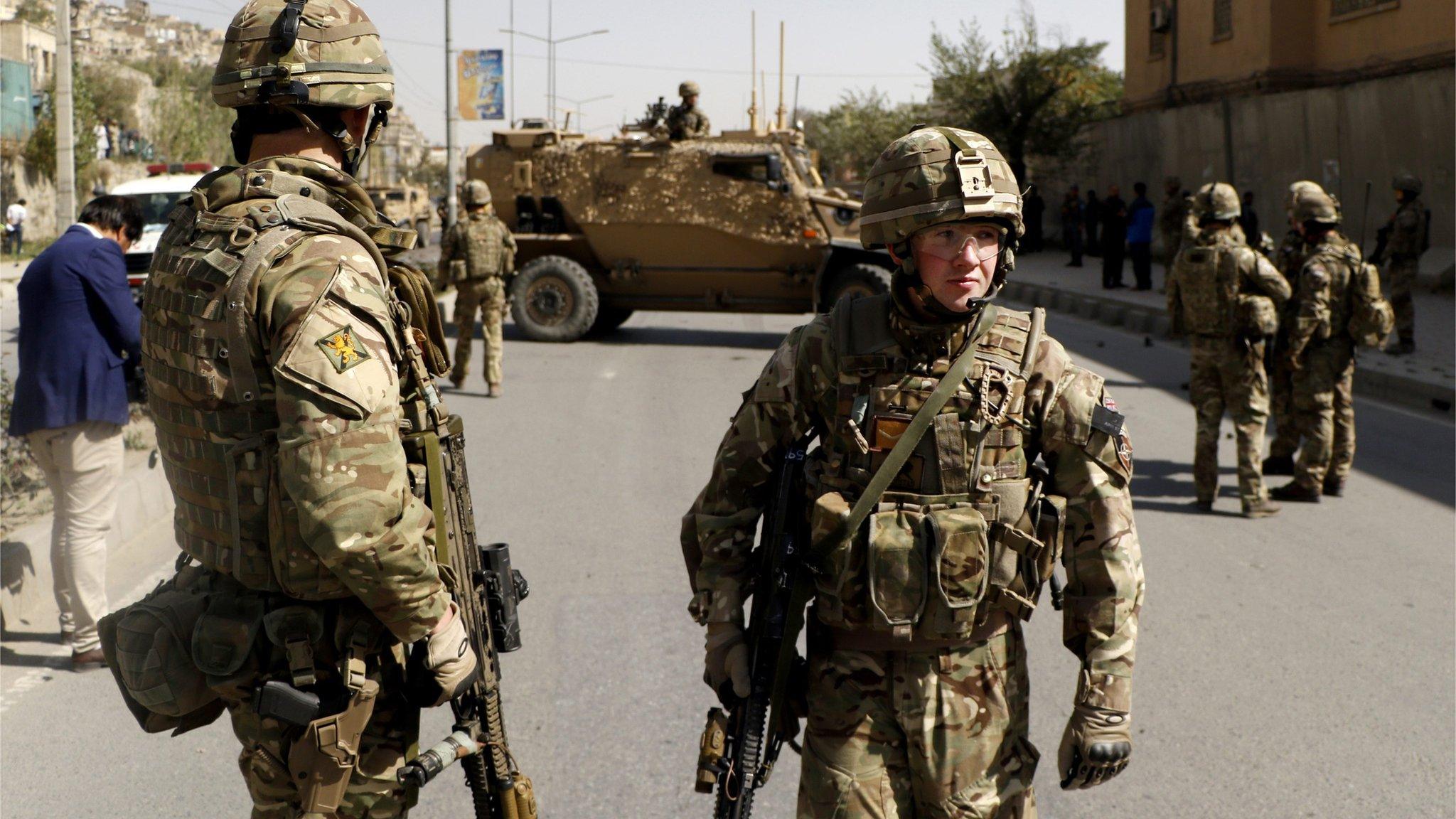Afghan officer academy opens its doors
- Published
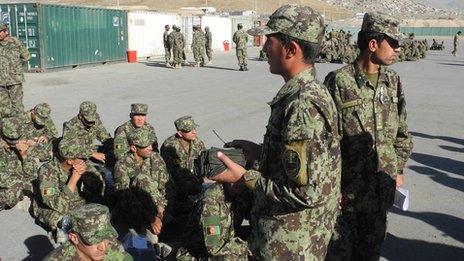
The new officer academy has been set up to teach its Afghan recruits key skills such as map reading, drill and field craft

On their first day, officer cadets received rations and equipment, and took a trip to the barber for a military haircut

Each one received their individual name tag, although the aim is to unite them under a single Afghan identity, over-riding any tribal ties
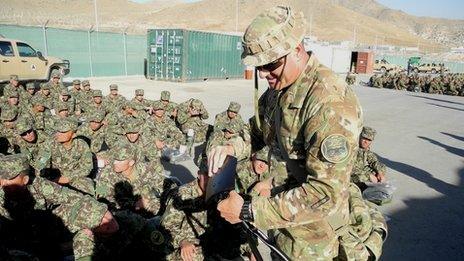
Skill at using arms is also crucial - here an Australian instructor demonstrates
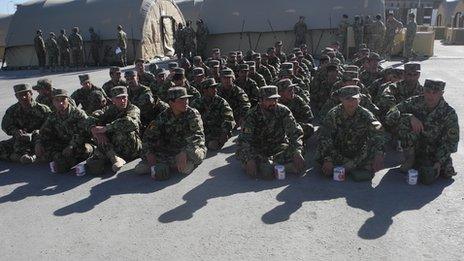
The hope is that with better training for the Afghan National Army, fewer lives will be lost
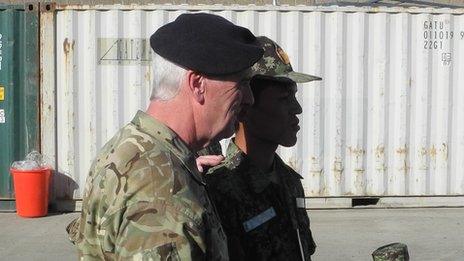
The academy will be Britain's only military presence in the country once the main troop withdrawal is completed in 2014
The first cadets for the new Afghan National Army officer academy could not all arrive on the same day, because travel from the country's outlying provinces can be hazardous.
But as term begins, more than 200 of the expected 270 new recruits in the first intake are in place.
The academy, which is modelled on The Royal Military Academy Sandhurst in the UK, will be Britain's only military presence in the country once combat troops have left next year.
It aims to take raw but enthusiastic candidates and turn them into the military leaders of the future, able to lead the growing ranks of ordinary Afghan soldiers.
Tent or palace
The recruits have come from all over the country, and from a wide range of backgrounds. One group queuing up to receive their uniforms, basic sports kit and toiletries included a teacher, a tailor and several recent university graduates.
They said they had joined up to defend their country - and they know the scale of the challenge ahead when international troops pull out.
More than 1,000 Afghan soldiers were killed last year, with 3,000 seriously injured.
The former tailor, Mohammed Navid, from the north of the country, said: "After 2014 all of the American forces will have gone from my province. We have to achieve our security."
The ex-teacher, Sadek, said he wanted to serve his country, but was frank about needing a job.
A makeshift army camp in tents is housing the first students, as the academy buildings will not be completed for another year.
But "it doesn't matter if we are in tents or in a palace", according to Lt Col Graham Hyland, who is leading a team of mentors from the UK, Australia, New Zealand, Norway and Sweden.
"The key thing is getting started, and getting young warrior leaders that the Afghan National Army wants out on to the field."
Ordered around
A visit to the camp barber was the first necessity for the recruits, where a close "number one" cut was the only style on offer.
Then they were put into small units - "tolay" in Afghan army jargon. Part of the Sandhurst method is that each tolay should be led by a regular army sergeant, and much of the instruction is by sergeants and other non-commissioned officers, or NCOs.
David Loyn reports from the 'Sandhurst in the sand'
Culturally, it might have been problematic to expect officers to be ordered around by a sergeant, but those running the course hope that once the system is accepted, this will improve relationships in the Afghan army beyond the officers, boosting leadership skills throughout.
Col Hyland said it had been a challenge at first when the instructors were being trained, but the substance of the course was what mattered.
"They're instructing them in all of the tasks we would have the senior NCOs at Sandhurst doing - in drill, skill at arms, map reading, and fieldcraft."
The academy is set in a long, low ridge of hills close to Kabul, with plenty of open ground to learn tactics. And the course has been altered significantly to make it Afghan-specific.
The military history syllabus includes the analysis of Afghan tactics in past wars against the British, as well as during the mujahideen wars against the Soviet army.
There were 10,000 applicants and they were examined anonymously, so theoretically it should not be possible for influential families to secure a place.
Without any artificial quotas, those accepted broadly reflect the tribal divisions of the country. This will be far harder to do when the women's course begins next year, as almost all of the female candidates have been from the Hazara ethnic group - the third largest in the country.
'Sponges'
The overall British commander, Brig Gen Maurice Sheen, said it was important to forge an Afghan national identity in the academy, and not focus on tribal and ethnic backgrounds.
He said the country had a warrior tradition, but recruits needed to be taught to be tactically aware.

There is a view among international advisers to the Afghan National Army that casualties within its ranks are higher than they need to be, and better leadership in the field would reduce them.
Gen Sheen said the students were willing to learn: "They'll sit for a long long time - quite deferential - which can be a problem at times because we have to encourage them to ask more questions.
"They have a longer concentration span than we have and seem like sponges. They are open to whatever we are telling them."
This first intake will emerge fully qualified as officers next September, and there will be two more groups joining during the year.
For those who have been working over the past year to deliver the course, like Col Hyland, watching the new recruits arrive was a good moment.
"I couldn't help but grin the whole day," he said. "It was really delightful to see them, cutting around and doing stuff, getting their kit issued, all those sorts of things.
"All those vague memories I have got of Sandhurst, and now here we are at the officer's academy at Qargha - it was really good. I was really proud."
- Published21 March 2013
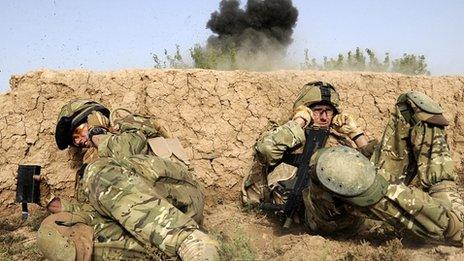
- Published14 April 2013
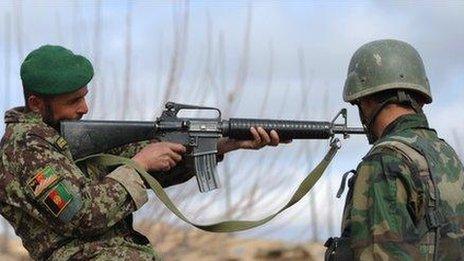
- Published15 October 2015
